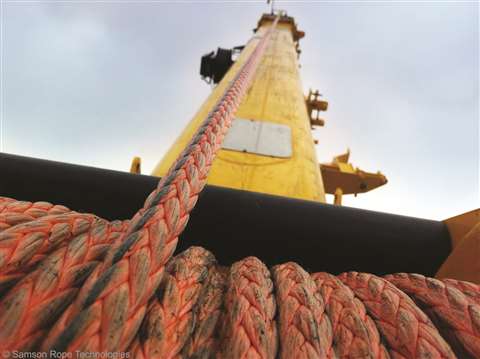Alternative rope
01 March 2017

In an industry where safety is the Number One priority, equipment upgrades that improve the working environment are constantly on the minds of crane owners and operators. For decades, steel wire hoist lines have been the standard in the industry, and while crane operators respect the inherent danger of working with wire, they also accepted that there were no other options. But in 2014 Samson introduced K-100, the first synthetic hoist rope designed specifically for mobile cranes. This launch represented the introduction of a new enabling technology to an industry trying to lift larger payloads at greater reaches.
Synthetic crane hoist lines are lighter, faster and more efficient for crane operations than the steel wire rope they replace. In addition to the lengthy testing and qualification program completed before their launch, Samson can now report two years of successful use in the field, and the associated learnings from that use. As this product’s adoption continues to grow, the continuing commitment by Samson and others to the industry, with investments being made for increased capabilities in data monitoring, testing, field use results and development, will expand the product portfolio.
Currently, K-100 remains the first and only OEM-approved, commercially operating synthetic crane hoist cable for mobile cranes in the market. Other quality rope manufacturers are currently in development and expected to join the market with similar products in the near future, indicating a growing acceptance of the use of synthetics in this field.
Synthetic crane hoist lines are now being used on more than 15 cranes operating in the field. With pending installations, this synthetic crane hoist line usage will be spread across four continents. Two major crane OEMs have approved the synthetic line for use on a large selection of rough terrain, truck crane and boom truck models. In addition to these approvals and installations, Manitowoc’s all-terrain products are joining the pack with customer field trials already in progress. Additional OEMs are evaluating the product, and Samson is expected to have news to share on this in the coming months. Documenting performanceNew technologies in traditional applications require endless education of the value proposition inherent with synthetic fiber hoist lines. To advance industry understanding, Samson has worked closely with standards committees, training entities, OEMs, rental fleet owners and crane operators on the selection, handling, inspection and retirement of synthetic lines. To continue the march forward, Samson is conducting an ongoing monitoring and data collection program to document the field performance of this revolutionary product. This program includes inspections, sampling, temperature monitoring and residual strength-testing on rope samples from the field. The testing plan is providing continued evidence that synthetic crane hoist lines are performing as predicted with customers considering repeat purchases for additional installations.
Crane owners and operators are experiencing and appreciating the added value promised with removal of spin, weight reduction, easier and faster reeving, no lubricant required, no cleaning of lube to inspect, as well as the ability to inspect both internally and externally. There have been zero reports of damage due to bird caging or kinking and any diving experienced has been easily and effortlessly recovered.
Interestingly, there have been additional user benefits recognized that were not predicted, including increased visibility of the hoist rope and no entanglement of K-100 when passing by or through obstructions – as sometimes found with the fish hooks on steel wire, (i.e. tree branches, etc.).
Crane operators are pleased with a quieter ride on the road as there is no noise from or damage to the boom when the rope makes contact during transport. At an installation in Qatar, operators found the rope efficient and clean to reeve. Eliminating the use of lubricants saves time and money – no longer having to clean spilled lubricant from the soil, avoiding the danger of environmental impacts altogether.
It’s a paradigm shift for many individuals to make the switch from steel wire to synthetic hoist lines. However, customers who now have experience with synthetic crane lines are delighted by the benefits seen on rough terrains, truck-mounted cranes and boom trucks in markets including construction, utility, arborist, energy, U.S. Navy shipyards, and shipbuilding facilities. In the future there will be even more value as large all-terrain cranes, crawlers, and additional classes of cranes take advantage of synthetic hoist solutions.
Crane manufacturers, rope producers and other industry stakeholders are committing resources to develop industry standards for the use of this technology. The standards work now taking place with ASME and FEM demonstrates the industry’s belief that this is the future.
To best support custom-designed solutions, Samson has recently completed a large investment in a custom-designed winch tester that will provide increased proof of performance and reliability studies. This equipment will allow for the simulation spooling and fatigue scenarios often found in the field application, thereby supporting on-going development efforts.
Use of continued feedback from the field in the development process will enable the continued expansion of crane hoist rope products. Samson is committed to providing safe, reliable technology advancements to the crane industry.
STAY CONNECTED


Receive the information you need when you need it through our world-leading magazines, newsletters and daily briefings.
CONNECT WITH THE TEAM







